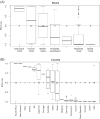Global effects of non-native tree species on multiple ecosystem services
- PMID: 30974048
- PMCID: PMC6850375
- DOI: 10.1111/brv.12511
Global effects of non-native tree species on multiple ecosystem services
Abstract
Non-native tree (NNT) species have been transported worldwide to create or enhance services that are fundamental for human well-being, such as timber provision, erosion control or ornamental value; yet NNTs can also produce undesired effects, such as fire proneness or pollen allergenicity. Despite the variety of effects that NNTs have on multiple ecosystem services, a global quantitative assessment of their costs and benefits is still lacking. Such information is critical for decision-making, management and sustainable exploitation of NNTs. We present here a global assessment of NNT effects on the three main categories of ecosystem services, including regulating (RES), provisioning (PES) and cultural services (CES), and on an ecosystem disservice (EDS), i.e. pollen allergenicity. By searching the scientific literature, country forestry reports, and social media, we compiled a global data set of 1683 case studies from over 125 NNT species, covering 44 countries, all continents but Antarctica, and seven biomes. Using different meta-analysis techniques, we found that, while NNTs increase most RES (e.g. climate regulation, soil erosion control, fertility and formation), they decrease PES (e.g. NNTs contribute less than native trees to global timber provision). Also, they have different effects on CES (e.g. increase aesthetic values but decrease scientific interest), and no effect on the EDS considered. NNT effects on each ecosystem (dis)service showed a strong context dependency, varying across NNT types, biomes and socio-economic conditions. For instance, some RES are increased more by NNTs able to fix atmospheric nitrogen, and when the ecosystem is located in low-latitude biomes; some CES are increased more by NNTs in less-wealthy countries or in countries with higher gross domestic products. The effects of NNTs on several ecosystem (dis)services exhibited some synergies (e.g. among soil fertility, soil formation and climate regulation or between aesthetic values and pollen allergenicity), but also trade-offs (e.g. between fire regulation and soil erosion control). Our analyses provide a quantitative understanding of the complex synergies, trade-offs and context dependencies involved for the effects of NNTs that is essential for attaining a sustained provision of ecosystem services.
Keywords: biological invasions; cultural ecosystem services; exotic trees; forestry; global assessment; meta-analysis; provisioning ecosystem services; regulating ecosystem services.
© 2019 The Authors. Biological Reviews published by John Wiley & Sons Ltd on behalf of Cambridge Philosophical Society.
Figures




References
-
- * Akinnifesi, F. K. , Kang, B. T. & Ladipo, D. O. (1998). Structural root form and flue root distribution of some woody species evaluated for agroforestry systems. Agroforestry Systems 42, 121–138.
-
- * Allison, J. D. , Borden, J. H. & Seybold, S. J. (2004). A review of the chemical ecology of the Cerambycidae (Coleoptera). Chemoecology 14, 123–150.
-
- * Allison, S. D. , Nielsen, C. & Hughes, R. F. (2006). Elevated enzyme activities in soils under the invasive nitrogen‐fixing tree Falcataria moluccana . Soil Biology & Biochemistry 38, 1537–1544.
-
- * Almeida, J. & Freitas, H. (2006). Exotic naturalized flora of continental Portugal – A reassessment. Botanica Complutensis 30, 117–130.
-
- * Aragon, R. , Montti, L. , Ayup, M. M. & Fernandez, R. (2014a). Exotic species as modifiers of ecosystem processes: litter decomposition in native and invaded secondary forests of NW Argentina. Acta Oecologica‐International Journal of Ecology 54, 21–28.

